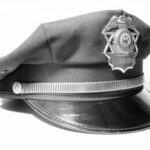The United States Air Force Security Forces are the internal law enforcement and security arm of the United States Air Force. This worldwide law enforcement force ensures air superiority and dominance through ground security operations. They are referred to as Security Forces by the rest of the world, but to members of the U.S. Air Force, they are simply referred to as “the cops.
The Air Force Security Forces are responsible for securing Air Force installations, property, and personnel as well as for providing law enforcement services on Air Force installations or where assigned. Specific tasks which Air Force Security Forces members can be called upon to perform include gate operations / entry control, law enforcement patrol, dog handler, armorer, weapons instructor, law enforcement / security instructor, D.A.R.E. instructor, game warden, personal protection specialist, flight line security constable, local police liaison, mentor / trainer to foreign police officers overseas, criminal investigator, local intelligence gatherer, host nation liaison, military court bailiff, military / nuclear convoy operator, correctional custody officer, customs inspections, tower / observation post, counter sniper, shift leader, turret gunner, alarm monitor / administrator, SWAT / Emergency Services Team member, heavy vehicle operator, and dispatcher.
For acceptance into the U.S. Air Force Security Forces, new recruits must first enlist in the U.S. Air Force. Upon completion of Air Force basic military training at Lackland Air Force Base in San Antonio, TX, recruits are placed on a bus with all of their issued gear and driven ten minutes across base for introduction to the U.S. Air Force Security Forces Academy. It is while in the academy that recruits learn the basics of law enforcement, installation security, nuclear security, and operating in a contingency environment.
It is not until after their graduation ceremony, after having officially recited the Security Forces Pledge, that Security Forces members are authorized to wear their badges and berets as part of their permanent uniform. From graduation day the academy graduates are shipped off to their first duty assignment, which could be any Air Force base in the world.
Security Forces members stationed at highly populated bases will receive much more hands on experience in security and law enforcement and may have to respond to incidents of personnel driving under the influence, domestic violence, shop liftings, drunk and disorderly conduct, fights, or unauthorized persons on base within the first week or two of reporting for duty. Those at smaller bases will still experience this type of work but the pace will be much slower and much more noticeable.
Currently, members of the Air Force Security Forces receive their authority from federal statutes. They have the authority to fully apprehend military violators of law anywhere in the world. Security Forces members also have the authority to detain civilian violators of state and federal law while those civilians are on Air Force installations. Security Forces members are generally authorized to engage in pursuits off of the installation as long as certain circumstances exist. For example, the crime which warranted the pursuit would have to have been committed in the presence of the Security Forces member or have been of such a severe degree that to not pursue the subject may inflict greater harm upon the public.
When Security Forces do detain a civilian, they will hand the civilian over to local police for processing and the Air Force will usually follow up by bringing the offender in front of a federal magistrate where fines, jail, and prison sentences may be handed out. Basically, no matter what the status is of the offender, military or civilian, Security Forces will take every step necessary to maintain order and discipline on the installation.
As military law enforcement officers, Security Forces members must remember that while they are on duty they represent the authority of the installation commander. The installation commander is the highest ranking person on base at all times. This is in order to maintain order and discipline. Security Forces members are authorized by federal law and their respective installation commanders to apprehend and detain any threat to good order and discipline, no matter the rank, status, or position of the offender. This is true for violators of the most serious crimes all the way down to violators of the simplest traffic infractions. It is the responsibility of each individual Security Forces member to learn how to act wisely and responsibly with the authority he or she has been granted while still being able to remain firm, impartial, and in control.
Sources:
Security Forces – 3P0X1. U.S. Air Force.


